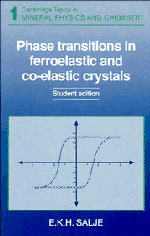Book contents
- Frontmatter
- Contents
- Errata
- Preface
- A brief guide for the reader
- 1 Introduction and some definitions
- 2 Ferroelastic and co-elastic phase transition
- 3 The Landau potential
- 4 The spontaneous strain
- 5 Coupling between the spontaneous strain and the order parameter
- 6 Macroscopic classification of ferroic and co-elastic crystals
- 7 Ferroelastic and co-elastic twin structures
- 8 Domain mobilities and elastic instabilities in ferroelastic and co-elastic materials
- 9 Specific heat anomalies and the excess entropy
- 10 Coupling between order parameters in ferroelastic and co-elastic crystals
- 11 Gradient coupling and strain modulations
- 12 Some aspects of the kinetic behaviour of ferroelastic and co-elastic crystals: an outlook
- References
- Appendix: An atomistic model for the Landau potential and the origins of the saturation effect
- Index
2 - Ferroelastic and co-elastic phase transition
Published online by Cambridge University Press: 03 May 2011
- Frontmatter
- Contents
- Errata
- Preface
- A brief guide for the reader
- 1 Introduction and some definitions
- 2 Ferroelastic and co-elastic phase transition
- 3 The Landau potential
- 4 The spontaneous strain
- 5 Coupling between the spontaneous strain and the order parameter
- 6 Macroscopic classification of ferroic and co-elastic crystals
- 7 Ferroelastic and co-elastic twin structures
- 8 Domain mobilities and elastic instabilities in ferroelastic and co-elastic materials
- 9 Specific heat anomalies and the excess entropy
- 10 Coupling between order parameters in ferroelastic and co-elastic crystals
- 11 Gradient coupling and strain modulations
- 12 Some aspects of the kinetic behaviour of ferroelastic and co-elastic crystals: an outlook
- References
- Appendix: An atomistic model for the Landau potential and the origins of the saturation effect
- Index
Summary
Here the term ‘co-elastic’ is formally defined as a generalisation of ferroelasticity. It is argued that both ferroelastic and co-elastic phase transitions can be treated within the framework of Landau-Ginzburg theory and that is exactly what will be done later.
When a ferroelastic crystal is heated we usually find that the ferroelastic effect disappears at a well defined temperature. At this temperature a structural phase transition between a ferroelastic and a paraelastic phase takes place with the main feature being that a ferroelastic hysterisis exists in one phase but not the other. A possible transition mechanism is that the thermal excitation of domain switching occurs in such a way that the crystal maintains the crystal structure of the ferroelastic phase on a local scale even in the paraelastic phase. The domain boundaries between the different ferroelastic domains would be highly mobile and thus no macroscopic domain switching is possible; the crystal is macroscopically paraelastic. This transition behaviour has indeed been observed in very few ferroelastic materials, such as high purity lead phosphate, and we shall comment on the significance of mobile domain boundaries in Chapter 8. In the vast majority of all ferroelastic crystals, however, one finds that the physical mechanism of the transition between the paraelastic and ferroelastic phase is only indirectly correlated with the ferroelastic effect itself. Looking at it in a different way we may ask ourselves what makes a crystal ferroelastic.
- Type
- Chapter
- Information
- Publisher: Cambridge University PressPrint publication year: 1991
- 4
- Cited by



